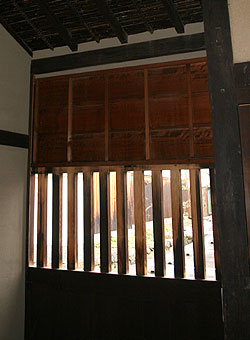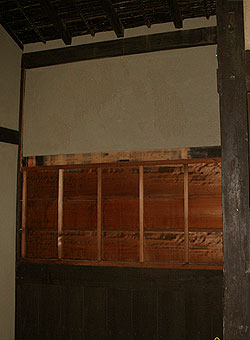| Lit.
push-up door. A variety of upward-opening door or shutter used during
the Edo period in urban merchant and artisan houses *machiya
町家. Agedo were developed to allow the front of the machiya,
which typically abutted the street and functioned as a shop *mise
店, to be opened up during the day and closed at night. There are two main
types: 1) vertically sliding shutters and 2) top-hinged shutters. The vertically
sliding shutters are referred to also as suriagedo 摺上げ戸 or, in Fukuoka
prefecture, oshiagedo 押上げ戸. These shutters were constructed in vertical
slots formed in the sides of the posts supporting the structural bay in
which they were set. Each shutter extended the full width of the bay, and
there were usually two or sometimes three shutters to a bay, mounted one
above the other. When closed they could be locked in place from the inside
with a wooden peg. The shutters were opened by sliding them upwards one
after another and they were stowed on a shelf, usually built on the top
surface of a stout lintel beam *douzashi
胴差 or sashimono 差物. A pocket which functioned as a vertical shutter
box *tobukuro 戸袋,
was created within the wall, and rendered invisible on the outer wall face.
To reduce obstructions at the front of the shop, more complete, heavy lintels
often were used to create a double-width, 2*ken
間, structural bay with a detachable post inserted midway to attach the
agedo when closed, but removable when opened. A fine example of agedo
used in combination with a detachable post is the shopfront of the late
17c Wachuusan Honjin 和中散本陣 in Shiga prefecture. Another example, the Kometani 米谷 house in Imaichou 今井町, Nara, illustrates a similar system that
also could be used to close the shop to the earth-floored passage *tooriniwa
通り庭, within the house. The second type of agedo is a top-hinged shutter,
also referred to as tsuriagedo 吊り揚げ戸, tsurishitomi 吊り蔀, or
ageshitomi 揚げ蔀. Essentially a form of hinged shutter *shitomido
蔀戸. Judging from early illustrations, such as the "Illustrated Handscroll
of the Legends of Mt. Shigi" Shigisan engi emaki 信貴山縁起絵巻, hinged shutters
had been used in urban houses, machiya, since at least the 12c. However,
while most Edo period examples open inwards, these illustrated examples
opened outwards, and were supported when open by stout metal hoods tsurikanagu
吊金具, suspended from the floor joists of the lofts above. Top-hinged shutters
were used not only at the front of the shop, but also for the main entry
*oodo 大戸, to the earth-floored
area *doma 土間, especially
in cases where the width of the front part of the earth floor was too narrow
for a conventional, horizontally sliding entrance. Examples of this kind
of agedo are numerous among the traditional town houses of Takayama
高山, Gifu prefecture. When used for a main entrance, the agedo is
a single leaf door, usually solid, but occasionally latticed, often with
an inset wicket door *kugurido
潜り戸, like many conventional entrances. When used at the front of the shop,
it might be either of solid or latticework construction. It often consists
of two or three leaves with hinged joints, allowing the individual leaves
to be folded in upon each other compactly, and raised without projecting
far into the room. Composite types in which the lower panel can be removed
by sliding it out vertically also exist. Only the upper panels are hinged
shutters. |




